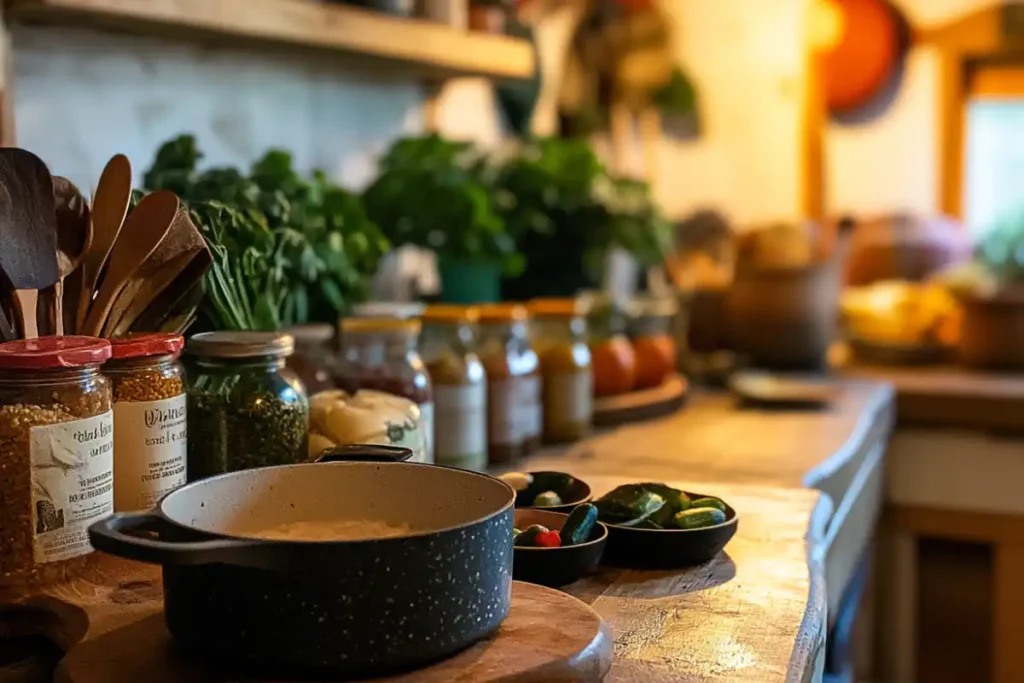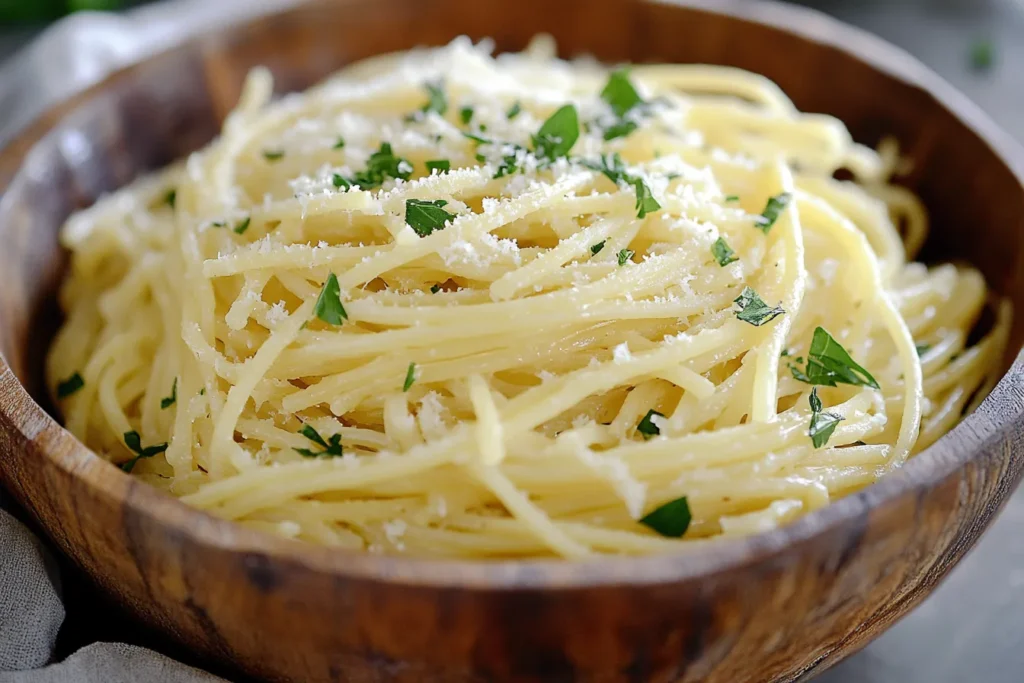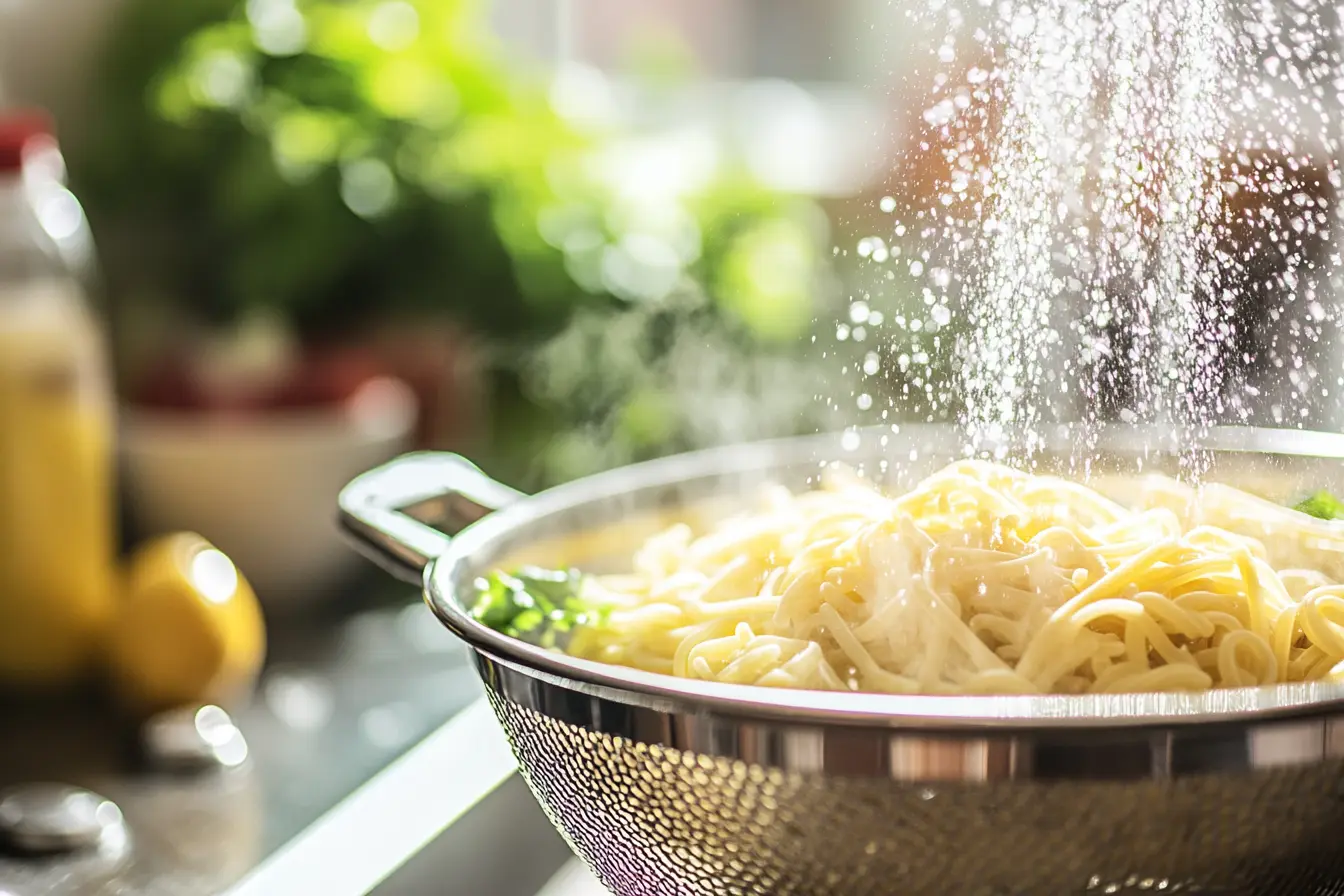Should you rinse pasta with cold water after cooking Pasta rinsing after cooking explained, with tips, best practices, and a simple recipe.
Should you rinse pasta with cold water after cooking In this article, we will uncover whether rinsing noodles is necessary, what culinary experts say, and how to handle delicate pasta shapes without ruining their texture. We will also provide a simple pasta recipe, along with smart tricks to improve consistency. Eventually, you will learn when to rinse, when to skip it, and how to achieve perfect pasta dishes every time.
Table of contents
Should you rinse pasta with cold water after cooking – Key Considerations
Should you rinse pasta with cold water after cooking This common question emerges because many home cooks worry about pasta sticking together. Initially, you might think rinsing stops overcooking. Basically, rinsing pasta in cold water removes surface starch. However, this may not always be beneficial. Indeed, every pasta dish demands a unique texture, and the rinsing step can alter flavor and consistency.
- Starch and Clinging Sauces
Comparatively, pasta starch helps sauces cling. Consequently, if you wash it away, sauces may slide off. - Traditional Practices
Historically, Italians rarely rinse pasta unless making a cold salad. Thus, tradition leans against rinsing. - Temperature Impact
Cold rinsing stops cooking, but equally halts proper integration between pasta and sauce.
In general, consider the dish you plan. If it’s a hot pasta served with a creamy sauce, you may not want to rinse. Meanwhile, for a cold pasta salad, rinsing might help achieve a fresher taste and prevent clumping.
Should you rinse pasta with cold water after cooking – Pros and Cons
Should you rinse pasta with cold water after cooking needs careful thought. Eventually, understanding the pros and cons helps you decide what’s best for your culinary goal.
Pros of Rinsing
- Prevents Clumping:
Another advantage is that rinsing removes some starchy residue, keeping the noodles separated. - Cools the Pasta for Salads:
If you plan a chilled pasta dish, rinsing helps the noodles cool rapidly. Consequently, it prevents the salad dressing from becoming sticky. - Stops Residual Cooking:
Because hot pasta continues cooking after draining, rinsing in cold water halts this process, resulting in the ideal al dente texture.
Cons of Rinsing
- Removes Starch for Sauce Cling:
Nevertheless, starch on pasta surfaces acts as a natural binder for sauces. Without it, the sauce may not adhere well. - Dilutes Flavor:
Conversely, rinsing can wash away subtle wheat flavors, making the final dish less robust. - Unnecessary Step for Hot Pasta Dishes:
Generally, for hot pasta and sauces, rinsing isn’t needed. Indeed, professional chefs rarely recommend it.
Comparatively, weigh these pros and cons based on your desired outcome. If preparing a warm, savory pasta dish that relies on a luscious sauce, skipping rinsing is wise. Conversely, if preparing a cold pasta salad, rinsing might improve texture and presentation.
Should you rinse pasta with cold water after cooking – Common Mistakes
Should you rinse pasta with cold water after cooking The topic often leads to confusion, and many home cooks make the following missteps:
- Rinsing All Pasta Types:
Undoubtedly, not all pasta is the same. Thick spaghetti might benefit from starch, while delicate shapes for salads might need rinsing. - Over-Rinsing:
Particularly, some cooks run pasta under water for too long, washing away too much flavor and starch. - Ignoring the Sauce Type:
Equally important, consider the sauce. A heavy cream sauce adheres better to unrinsed pasta.
Instead of mindless rinsing, pause and think about the recipe. Indeed, careful decision-making prevents a bland or watery dish.
When Should you rinse pasta with cold water after cooking Does More Harm Than Good
When Should you rinse pasta with cold water after cooking is applied to a rich, hearty dish with a thick sauce, you diminish the flavor. Hence, the sauce can’t cling well, and the meal feels less cohesive. In this case, do not rinse. Moreover, some pasta shapes, like bucatini, contain hollows that trap sauce. Rinsing removes the starch that helps sauce remain inside, resulting in a less satisfying bite.
Expert Opinions on Should you rinse pasta with cold water after cooking
Experts generally advise against rinsing hot pasta that’s destined for a warm sauce. At culinary schools, students learn that starch is valuable. Esteemed chefs often say no to rinsing, except for cold salads or certain Asian noodle recipes. Pasta authorities stress that the natural starch coating is vital for achieving a restaurant-quality finish.
Alternative Approaches to Should you rinse pasta with cold water after cooking
Instead of Should you rinse pasta with cold water after cooking, consider other methods:
- Tossing with Sauce Immediately:
After draining, place pasta straight into the sauce. Accordingly, the starch helps the sauce stick. - Adding a Drizzle of Olive Oil:
Another solution is adding a small amount of oil after draining. This prevents clumping without rinsing. - Using Reserved Pasta Water:
Especially keep some starchy pasta water. Adding it to the sauce helps achieve a silky consistency.
By applying these methods, you maintain flavor and ensure optimal texture.
Understanding Pasta Starch and Texture

Starch is not an enemy; it’s a culinary ally. Should You Rinse Pasta with Cold Water? Not always, as rinsing washes away the starch that pasta releases during cooking, which creates a slightly sticky surface. This starch is essential for helping sauces and seasonings adhere to each strand, enhancing the overall flavor and texture of the dish. By removing it needlessly, you risk ending up with a bland result. Indeed, well-emulsified sauces heavily rely on the pasta’s natural starch to achieve that perfect, creamy consistency.
Key Points:
- Starch assists sauce adherence.
- Overcooking releases too much starch, leading to stickiness.
- Correct cooking time reduces the need for rinsing.
The Role of Surface Starch in Sauce Binding
Surface starch acts like a glue, which is why many ask, Should You Rinse Pasta with Cold Water? Leaving the starch intact ensures that cream sauces, tomato-based sauces, or even simple olive oil dressings adhere beautifully to the pasta. By retaining this natural starch, you achieve a harmonious blend of flavors and textures. Comparatively, rinsed pasta can wash away the starch, causing sauces to slide off and pool at the bottom of the plate, leaving the dish less cohesive.
Ideal Cooking Times to Prevent Overcooking
Initially, follow package instructions. Eventually, taste the pasta a minute before the suggested time. Because al dente texture is ideal, remove pasta once it reaches a firm but not crunchy bite. Consequently, there is no need for rinsing to halt cooking. Instead, carefully timing your boiling ensures perfect texture.
- Boil in salted water.
- Test pasta early.
- Drain when al dente.
Proper Draining Techniques Without Rinsing
Mastering the art of draining pasta effectively is an essential step in achieving the perfect texture and flavor in your dishes. Should You Rinse Pasta with Cold Water after cooking? In most cases, it’s unnecessary, as rinsing can wash away the starchy layer that helps sauces cling to the pasta. Instead, focus on proper draining techniques that preserve the pasta’s quality while ensuring it is free of excess water. By skipping the rinse and using these methods, you can enhance the overall flavor and consistency of your pasta dishes. Here’s a closer look at the best practices.
Using a Colander Efficiently
A colander is one of the most essential tools for draining pasta, but how you use it makes all the difference. Follow these steps to ensure optimal results:
- Act Quickly: As soon as the pasta reaches the desired doneness (preferably al dente), immediately transfer it to a colander. Letting pasta sit in hot water for too long after cooking can result in overcooking and a mushy texture.
- Shake Gently: Once the pasta is in the colander, shake it lightly to remove excess water. Avoid being too rough, especially with delicate pasta shapes like shells or lasagna noodles, to prevent breaking them.
- Avoid Overcrowding: If cooking a large quantity of pasta, drain it in batches to ensure water doesn’t pool in the colander and cause uneven cooling or clumping.
For added efficiency, place the colander over the sink or inside the pot to reduce spillage and manage hot liquids safely.
Reserving Pasta Water for Sauce
Pasta water, often called “liquid gold,” is an invaluable ingredient for elevating your pasta dishes. The starchy water left behind after boiling pasta serves multiple purposes, enhancing both texture and flavor.
- How to Reserve Pasta Water: Before draining the pasta, ladle or pour out about 1/2 to 1 cup of the cooking water into a separate bowl or container. This small step ensures you always have it on hand to adjust your sauce.
- Benefits of Pasta Water:
- Thickens Sauces: The natural starches in pasta water bind sauces, creating a smooth, velvety consistency without needing cream or butter.
- Balances Flavors: A splash of pasta water can help balance overly thick or concentrated sauces, ensuring even coating without diluting flavors.
- Encourages Emulsification: When combined with oils or fats in the sauce, pasta water forms an emulsion that helps the sauce cling to each noodle seamlessly.
Draining vs. Rinsing: Key Differences
It’s crucial to understand why draining is preferable to rinsing for most pasta dishes:
- Preserves Starch: Unlike rinsing, which washes away the starch on the pasta’s surface, proper draining keeps the starch intact, enhancing sauce adherence.
- Maintains Temperature: Draining ensures the pasta stays hot and ready for immediate incorporation into your sauce, avoiding the temperature drop that rinsing causes.
- Saves Time: Rinsing is an extra, often unnecessary step, while draining is quicker and more efficient for both hot and cold dishes.
Tools and Tips for Perfect Draining
To refine your draining technique, consider these additional tips:
- Use a Spider Strainer: For delicate pasta shapes or smaller quantities, a spider strainer allows you to scoop out pasta directly from the boiling water without transferring all the liquid.
- Tilt and Drain Method: If you’re short on time or don’t want to use a colander, slightly tilt the pot while holding the lid in place to pour out most of the water. This method works well for larger pasta shapes but may not be ideal for tiny varieties like orzo.
- Multi-Function Pots: Invest in a pasta pot with a built-in strainer lid to simplify the process and reduce cleanup time.
By mastering these proper draining techniques without rinsing, you’ll retain the pasta’s natural starch, enhance sauce integration, and ensure a perfectly balanced dish every time. For cold pasta salads or recipes that require rinsing, proceed only when necessary and with care to avoid washing away essential flavors.
Recipe Section – Classic Lemon Garlic Pasta

Now that we’ve explored the rinsing dilemma, let’s put theory into practice. Below is a recipe that demonstrates how to handle pasta perfectly, no rinsing required. However, if you plan to turn this dish into a chilled pasta salad, we’ll show you how rinsing might come into play.
Ingredients List (with emojis)
- 🍝 12 oz spaghetti (or linguine)
- 🧄 4 cloves garlic, minced
- 🍋 Zest and juice of 1 lemon
- 🧈 2 tbsp unsalted butter
- 🧂 Salt and pepper to taste
- 🌿 Fresh parsley, chopped (for garnish)
- 🥄 1/2 cup reserved pasta water (if needed)
- 🫒 2 tbsp extra-virgin olive oil
- 🧀 Grated Parmesan cheese (optional)
Step-by-Step Cooking Instructions
- Boil Water:
Initially, bring a large pot of well-salted water to a rolling boil. This is crucial because well-seasoned water flavors the pasta from within. - Cook the Pasta:
Add the spaghetti and stir occasionally. Basically, follow package directions, but test a minute early. Eventually, aim for al dente texture, so the pasta has a gentle bite. - Drain Without Rinsing:
Before draining, reserve about 1/2 cup of the pasta water. Now drain the pasta in a colander. Do not rinse with cold water. Accordingly, keep that starchy coating intact. - Create the Sauce Base:
Meanwhile, in a large sauté pan, warm olive oil over medium heat. Add minced garlic and stir until fragrant. Do not let it burn. Add butter, lemon zest, and lemon juice. Stir well. - Combine Pasta and Sauce:
Add the hot pasta directly into the sauce pan. Toss thoroughly. If it appears dry, add a splash of reserved pasta water. Consequently, the starch in the pasta water will thicken and bind the sauce. - Season and Serve:
Season with salt, pepper, and more lemon if desired. Top with fresh parsley and Parmesan cheese. Serve hot. Notice how the sauce clings beautifully. Thus, no rinsing was needed.
Note: If you wanted this dish as a cold pasta salad, you might consider rinsing the pasta right after boiling. Let it cool, then mix with additional olive oil and lemon dressing. However, remember that rinsing reduces starchiness and sauce adherence. Use this approach only if serving the pasta cold.
Nutritional Information (per 100g)
Nutritional Content Table (Approximate)
| Nutrient | Amount per 100g |
|---|---|
| Calories | 170 kcal |
| Carbohydrates | 30 g |
| Protein | 5 g |
| Fat | 4 g |
| Fiber | 2 g |
| Sodium | 70 mg |
- Carbohydrates provide energy.
- Protein supports muscle maintenance.
- Fat adds flavor and aids in nutrient absorption.
- Fiber ensures better digestion.
- Sodium should be monitored if on a low-salt diet.
FAQs about Should you rinse pasta with cold water after cooking ?
Q1: Do I ever need to rinse pasta for hot dishes?
Generally, no. Hot pasta dishes benefit from starch. Therefore, sauces stick better if you avoid rinsing.
Q2: Can I rinse pasta for cold salads?
Undoubtedly, yes. Rinsing cools it quickly, preventing clumping. Accordingly, it is helpful for dishes served cold.
Q3: Will rinsing reduce flavor?
Yes, comparatively, rinsing can wash away some natural wheat flavor. Thus, use caution if flavor depth matters.
Q4: Is it necessary to use pasta water in sauces?
It’s not mandatory. However, doing so enhances sauce texture. Furthermore, it reduces the need for extra cream or fat.
Q5: Can rinsing remove too much starch?
Absolutely, over-rinsing strips away essential starch. Consequently, the sauce may not adhere well.
Conclusion: Should you rinse pasta with cold water after cooking ?
Should you rinse pasta with cold water after cooking In conclusion, understanding when and why to rinse pasta ensures you achieve top-notch dishes. Eventually, rinsing suits cold salads or noodles you plan to serve chilled. Conversely, skipping the rinse is best for hot, saucy meals where starch is your ally. Thus, choose based on the dish. Undoubtedly, mindful cooking leads to better flavor, texture, and presentation.
